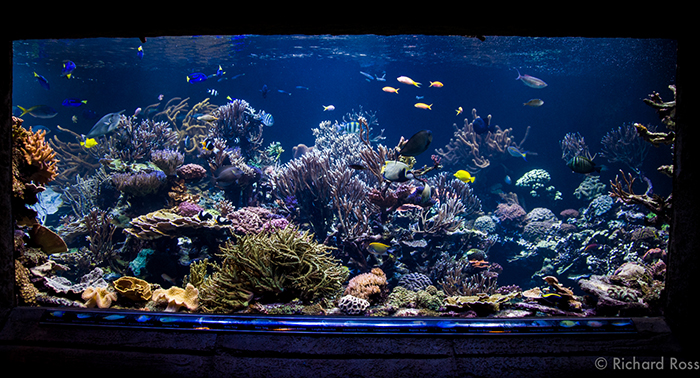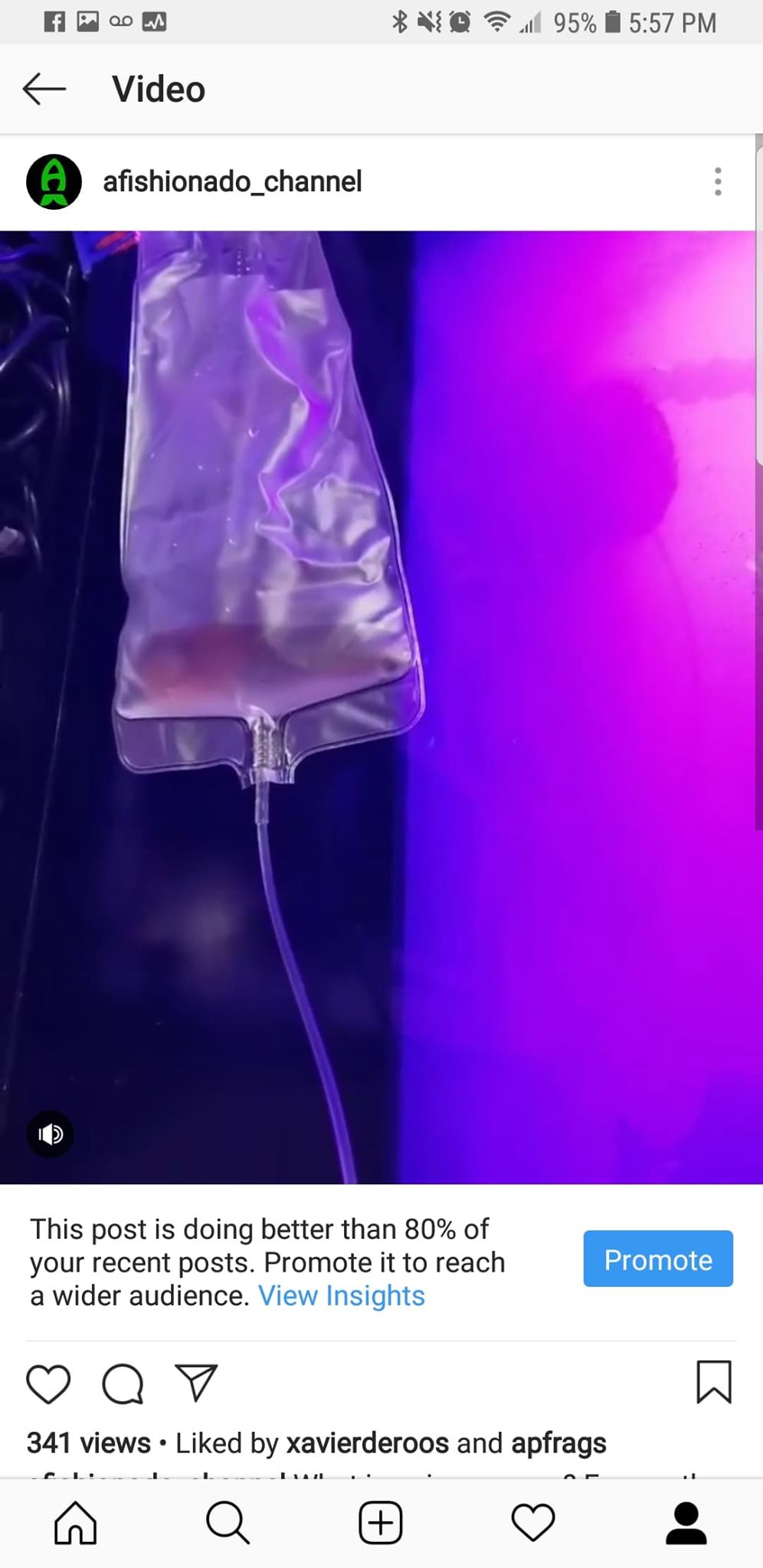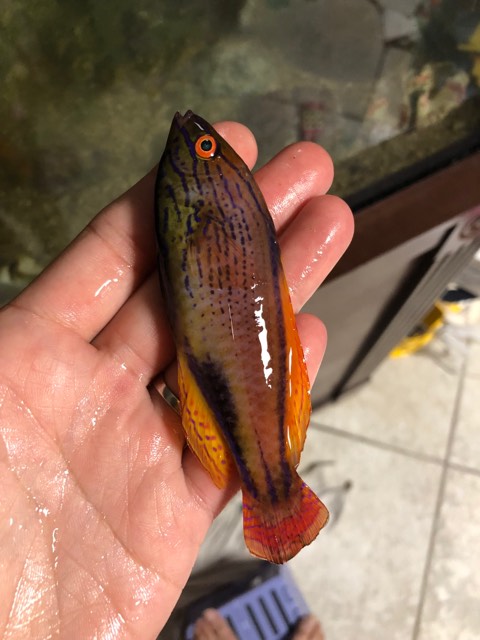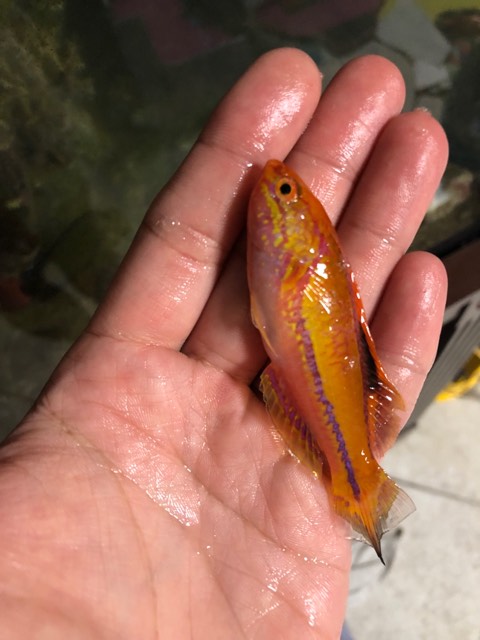This was an extremely painful experience and lesson for me. I don’t really want to write about it because it’s still so fresh on my mind, but I want people to learn from my mistakes and hopefully it help prevent heartaches for others. It’s definitely something that made me contemplate my ways in reef keeping and actually made me think that I should take a break.
Without further ado, This is my trials and tribulations with using Lanthanum Chloride (and what you should know about it)
Lanthanum Chloride is not new to the hobby. It’s a liquid chemical compound that many hobbyists and public aquarium keepers use to control phosphate in an aggressive manner. From small tanks to Joe Yaiullo’s 20000 gallon Long Island Aquarium reef exhibit, it’s widely used and accepted as great tool to remove phosphate from your system.

Joe Yaillo’s 20,000 gallon reef tank at the Long Island Aquarium and Exhibition Center is arguably one of the most successful reef tanks in the world. Joe says “I am very happy if I can keep it {phosphate level} at .12 ppm. Photo by Richard Ross.
For you science buffs, here is a science journal article from the Journal of Environmental Sciences explaining how it works.
For people like me who just want it in simple terms, LaCl3 binds with phosphate, drastically reducing the level of unwanted organic phosphate in the aquarium, and aids our corals with calcifing their skeletons to help them grow. Here is a excellent tutorial on how to use this in your system. (Video from Marc Levenson of Melev’s Reef.)
It sounds great doesn’t it? Magic cure for your unwanted organic phosphate in your system.
Here is what can happen from my research. (Possible Downside)
1.) Your pH will drop.
2.) Once P04 is consumed, Lanthanum will eat away at your alkalinity.
3.) Zebrasoma sp. may have hard time, labor for breath, but ultimately be ok.
4.) Once lanthanum binds with phosphate, it will become a larger particle and if not caught by your skimmer or mechanical filteration before entering your display tank, it can be detrimental to your fish in your tank.
From my research online, I saw another hobbyist who was using L.Chloride in his 300 gallon tank with great success. Following his formula of 5ml, I went down to 3.5ml for my 210 gallon, diluting it with RO/DI water and injecting it into the skimmer using an IV drip system.
What did I use and try to negate the negative side effects.
For my choice of Lanthanum Chloride, I used commercial grade Seaklear Phosphate remover. That’s what was readily available for me locally and from my readings and from videos online, people seem to have good success using it in reef aquariums. To compensate for the drop of alkalinity, I turned on my kalkwasser reactor before, during, and a bit after the treatment. To catch the larger lanthanum/phosphate particles, I used 100 micron filter socks at the skimmer output to catch the particles and then put a large amount of filter floor on the sump area where water travels from the skimmer chamber to the return chamber.

On with the treatment!
I thought I was ready. I thought wrong.
I started dosing the L.chloride to my skimmer and started to do a social media post regarding it. Within 45 minutes to one hour of dosing, the tank got extremely cloudy. I have seen reports of tanks clouding up but I was concerned so I stopped dosing. By now, 60%-70% of dose has entered the system via drip method. I noticed my favorite fairy wrasses (wrasses are my absolute favorite fish) on the sandbed laboring for breath.
Oh crap moment. This is what I did.
1.) Within 15 minutes, I did 10% of total volume water change. (*Always try to have extra water on hand for emergencies like this)
2.) Started more aggressive wet skimming to empty out more water and started making more fresh saltwater to compensate for the water being pulled out along with La/P04 particles. I did another 5 gallon water change this way.
3.) Replaced all the filter floss and socks, and continued to wash and replace them every 30 minutes.
4.) With the suggestion of Marc Levenson of Melev’s reef (thank you again by the way for calming me down past midnight.), I started to check alkalinity every 30 minutes and dosed sodium bicarbonate in small increments. (you can use regular baking soda)
Aftermath.


After everything cleared up around 3:00 am, 3 fairy wrasses perished due to my mistake. This is absolutely heartbreaking. These are my favorite type of fish and each of them have special meaning to me, and I had gone to great lengths to acquire some absolute stunning specimens. There is a possibility that may be more casualties with sand burrowing anampses wrasses, but I am trying to remain optimistic that they are ok and that they will survive. Oddly enough, the species who were supposed to be the most challenging for this treatment (zebrasomas) were perfectly fine and didn’t even flinch during the duration of the lanthanum chloride treatment.
What may have happened.
Human error. Let me clarify that.
- I didn’t calculate well enough. Possible overdose?
- I didn’t use small enough micron to capture all the particles and too much entered display tank and into the fishs’ gills and made my sensitive fish suffocate to death.
- I may have dosed too fast.
- I shouldn’t have trusted non-aquarium brand for our aquarium?
What I should have done.
- Should have been more patient.
- Should have done more research. Talk with people who had more first hand experience.
- Should have taken my time and dosed really slowly and not all at once but spread out over a few days.
- Should have had better mechanical filteration. Instead of using 100 micron socks, I should have used 10 micron socks.
- Should have used products that was made for our aquarium trade with proper instructions that were made after research was done to ensure the dosages were safe for the animals in my aquarium. Marc Levenson uses Blue Life USA’s Phosphate Rx and Julian Sprung also came out with his version of Lanthanum Chloride in Phosban L.
- Should have had my QT up just in case if any of my fish showed bad signs of respiration.
Final Thoughts.
I am not trying to discourage anyone from using Lanthanum Chloride as it is extremely effective in removing phosphates and perfectly safe as long as you take the necessary precautions and prepare for the worst case scenarios. Marc Levenson of Melev’s Reef has been using this method to remove phosphate for 13 years without any losses. What I want to accomplish from sharing my ordeal is to let people know that, as with dosing any chemicals into our aquarium, you need to be very cautious as it can have a fatal effect as you saw from my personal experience. Less is definitely more in this case and as everything in this hobby, slow and safe will win the race. Take some time to research, dose very slowly while observing very carefully, and use products that are formulated specifically for our aquariums.
Happy reefing.










Unfortunately, it is very difficult to research a product when the actual ingredient is not clearly stated. Continuum Aquatics PhosCorrex, only state their product to be ‘deionized water, proprietary phosphate remover’ so at the time I followed their rather irresponsible, laissez-faire instructions and lost a lot of my livestock. It was purely heartbreaking to watch so I can totally sympathize with your loss.
Continuum Aquatics to this date refuse to admit or clearly state that it is lanthanum chloride, but I eventually worked it out and had it tested so I know that it is lanthanum chloride. I really don’t understand the secrecy in hiding such ingredients as lanthanum chloride is not the brainchild of Continuum Aquatics – and this is utterly just irresponsible of them. I’ve lost all trust in their products and have since binned them all.
When used correctly, safely and with uttermost precautions lanthanum chloride can be a very effective tool in combating and dealing with phosphates, but again, very hard to do so when brands are not being fully upfront and honest by stating the actual ingredient.
I suspect that our aquarium safe products are watered down considerably compared to commercial grade products or products used in other applications. For example, if I did the conversion right, the L. chloride I just bought appears to be 10-12x stronger, drop for drop, than the aquarium product.
Dr. James Wood
Coral Sea Aquariums
Hey again,
I’m sorry this happened to you and while don’t want to take away from your overall message of being careful and following instructions, I don’t think the product was at fault. I think you accidentally overdosed by a factor of 3600%, I think drop for drop the product you used was much stronger.
I just did the math on ECO phosOUT, also a swimming pool product. It is 12.2 times stronger than the aquarium product Elimi-Phos Rapid by Tropic Marin.
ECO phosOUT says 32 fl will drop 10000 gallons 3 PPM. 10000 gallons is a lot of water! Then again, this stuff is for swimming pools.
Elimi-Phos Rapid says “10 mL per 26 gallons will reduce phosphate concentrations by up to 1 ppm.” So 1 ml does 2.6 gallons.
10000gal/32 oz x 3ppm/1 x 1 oz/29.57 ml = 31.7 gallons/ml for the pool stuff.
So drop for drop, the pool product I have is 1220% more concentrated than that specific the aquarium product.
Turns out that the pool product you bought is 3x stronger than the pool product I just bought. 32 fl oz of SeaKlear Phosphate Remover takes out 9 ppm in 10000 gallons of water. So I suspect that what you dosed was over 36 times stronger, drop for drop, than the aquarium product I compared to above. You used a reasonable dosage based on volume but the concentration of the active ingredient was much stronger in the product you used.
Dr. James
Owner of Coral Sea Aquariums
https://coralseaonline.com/
Hi! Thank you for taking your time to read and to provide your feedback. Yea, I definitely overdosed. I just went by whatever anedoctal formula available online and that was my first yet fatal mistake.
I had this happen to me and lost alot of fish. But i have a couple questions. Since noone said if you dose to much and realize you did.
If fish are struggling what can a person do to help their fish?